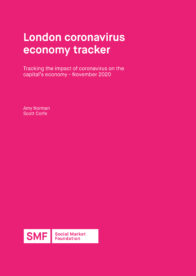This report, the third in a series commissioned by Peabody, updates our analysis of the impact of COVID-19 on London's economy. It explores the latest timely data on economic outcomes to produce an as up-to-date picture as possible.
Key findings:
- The latest claimant count data show unemployment continuing to rise in London. Between August and October, the claimant count increased by 1.2% in the capital, compared with a 3.7% fall for the rest of the UK. On this measure of unemployment, this amounts to a further 5,550 individuals out of work in the capital.
- About 2,200 18-24 year olds in London became unemployed between September and October, on the claimant count measure – far more than any other age group. Unemployment has started to fall back among those in older age groups, aged 30-60, after rising over the summer.
- There are four London boroughs where the unemployment rate, on the claimant count measure, is greater than or equal to 10%. These boroughs are Haringey (10.7%), Brent (10.3%), Barking & Dagenham (10.1%) and Newham (10.0%).
- New analysis of the May-July and June-August 2020 Labour Force Survey, presented here, suggests ethnic minorities are disproportionately likely to be among the newly jobless in the capital. Black Londoners account for 16% of the recently unemployed, despite accounting for 10% of the economically active population in the capital.
- In contrast to the UK as a whole, London has also seen a large number of professionals become unemployed alongside those in “elementary occupations”. That is to say, London’s economy appears to be shedding jobs at both ends of the income distribution.
- London’s job vacancies recovery is now running substantially behind the rest of the UK. While in the rest of the UK job vacancies have increased to just 11% below March levels, they remain 44% below March levels in the capital.
- While in March London had roughly one job vacancy per jobless benefits claimant, as of November we estimate that there are about 4.4 claimants for every job vacancy. This is higher than the 3.8 claimants per vacancy seen for the rest of the UK.
- Cost of living inflation for London’s social housing tenants has increased marginally from 0.4% in August to 0.5% in September. This is in line with the inflation rate seen for the UK as whole. Inflation remains low, reflecting declining prices for a range of consumer goods in the current downturn. This includes food, clothing and energy costs.

Download The Report: PDF
Kindly sponsored by

